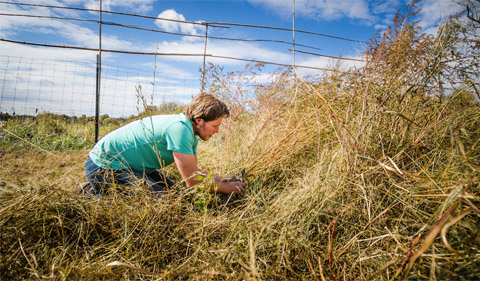
Dr. Paul Patton harvests Chenopodium berlandieri at the Plant Biology Learning Gardens.
Dr. Paul Patton‘s research on ancient seeds appeared in Nature Plants in July and was recently discussed by Dr. Bradley Lepper in The Columbus Dispatch.
Patton is an Assistant Professor of Anthropology and Food Studies in the College of Arts and Sciences at Ohio University and Director of the OHIO Archaeological Field School. His research colleagues are Dr. Natalie Mueller and Dr. Gayle Fritz (Washington University-St. Louis), Dr. Stephen Carmody (Sewanee-The University of the South), and Dr. Elizabeth Horton (Arkansas Archeological Survey).
When you think of the plants that eastern North American Indian farmers grew in their gardens and fields, corn is probably the first thing that comes to mind. But corn, or maize, was not a local plant. It was domesticated in Mexico and did not become important in Ohio until after about A.D. 900.
Ohio’s first farmers, beginning sometime after 5,000 years ago, relied instead on a number of local plants, including sumpweed, goosefoot, maygrass, erect knotweed and little barley. These plants, referred to collectively as the Eastern Agricultural Complex, helped to fuel the rise of Ohio’s spectacular mound-building cultures: the Adena and Hopewell.
Paul Patton, an archaeologist at Ohio University, and his colleagues not only excavate the burned seeds of these plants from ancient hearths and trash pits, but they also grow the plants in experimental gardens, both to gain insights into how particular plants were domesticated and to explore the potential benefits of adding them to our modern menus. Patton, along with co-authors Natalie Mueller and Gayle Fritz from Washington University in St. Louis, Stephen Carmody from Sewanee: The University of the South in Tennessee, and Elizabeth Horton of the Arkansas Archeological Survey, summarized what they have learned in the July issue of the journal Nature Plants.
Read Lepper’s article here.



















Comments